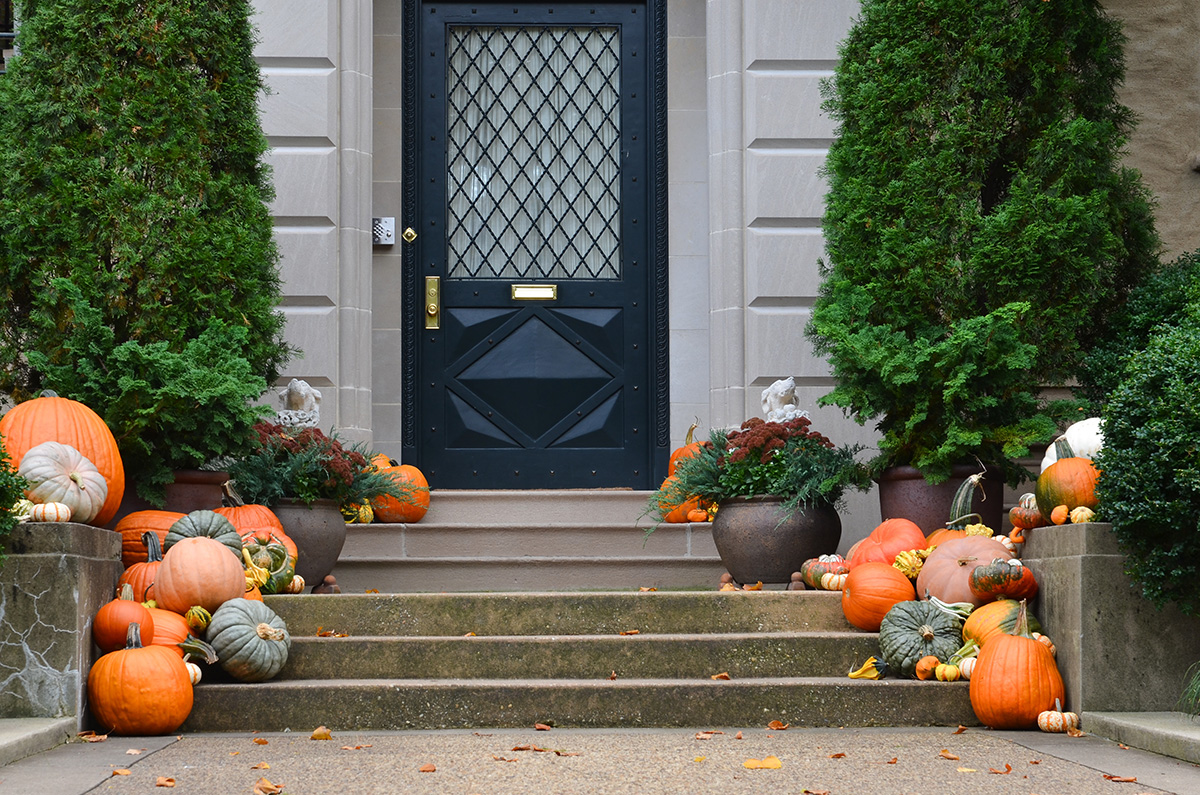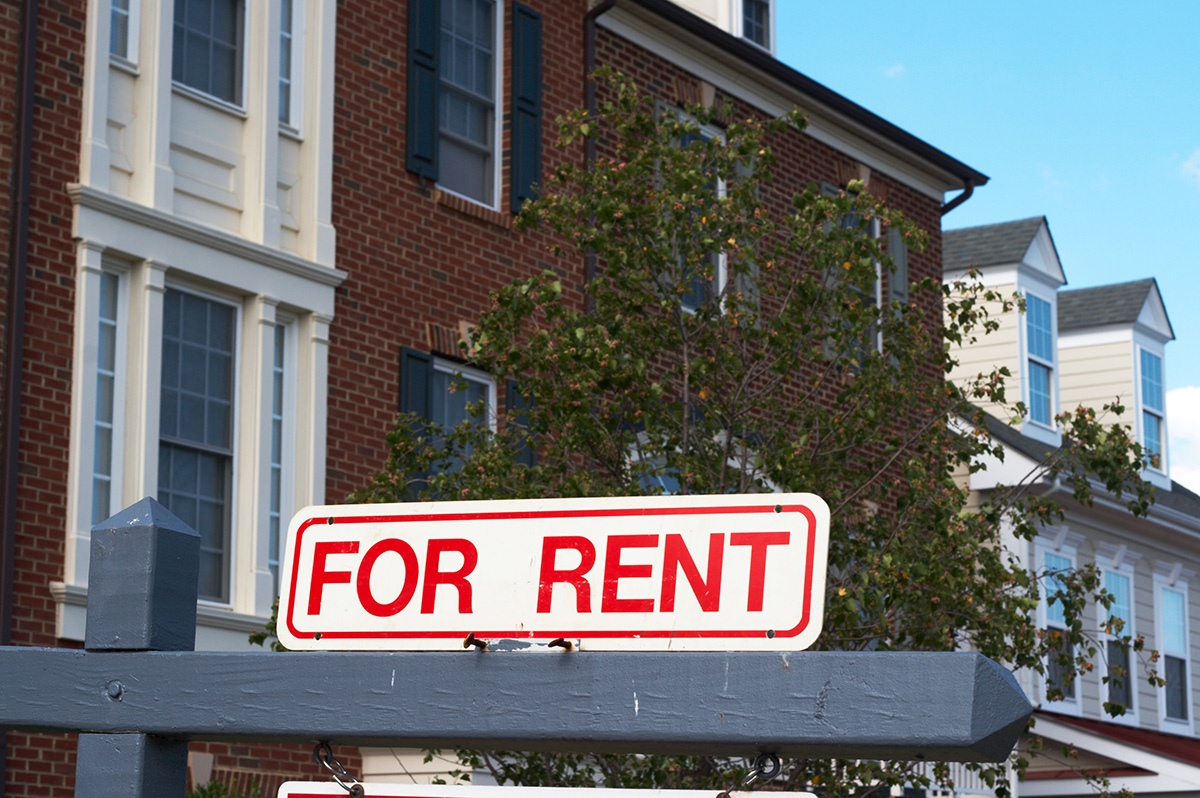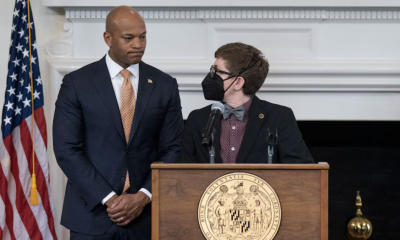Real Estate
Make your home shine this fall
Essential maintenance for LGBTQ homeowners

As the LGBTQ community continues to thrive and embrace homeownership, it’s important to ensure that our homes reflect both our values and our commitment to taking care of our spaces. Fall is the perfect season to focus on essential home maintenance, whether you’re preparing to sell or just want to keep your home in top shape. With a few seasonal updates, you can enhance both the beauty and protection of your home as we move into the cooler months. Here are some must-do fall maintenance tips, brought to you by GayRealEstate.com, to make your home shine.
1. Clean Your Gutters and Downspouts
As leaves begin to fall, they often collect in gutters, leading to drainage problems that can cause water damage. Clearing out debris will keep water flowing properly and protect your home’s foundation. It’s a simple task that can make a huge difference in preventing costly repairs later on.
LGBTQ Tip: A well-maintained home is a reflection of pride in ownership. Keep your property in top shape to show the world that your space is a part of the community’s progress and joy.
2. Seal Up Windows and Doors
A drafty home can lead to higher heating bills and discomfort as temperatures drop. Inspect your windows and doors for cracks or gaps and seal them with caulk or weatherstripping to keep the cold out. This also increases energy efficiency, an important consideration as we all work toward more sustainable living.
Pro Tip: This is a great way to save on energy costs, freeing up more budget for community activities or causes you care about.
3. Service Your Heating System
Fall is the perfect time to have your heating system serviced. An efficient system ensures that your home stays cozy throughout the cold months, and prevents any surprise breakdowns during the winter. For those with fireplaces, make sure to have the chimney cleaned and inspected.
LGBTQ Tip: Host friends and chosen family for cozy fall gatherings in a warm, comfortable home that’s ready for the season.
4. Roof and Chimney Check
Inspect your roof for damaged or missing shingles and check your chimney for cracks or blockages. Addressing these issues early can prevent leaks or other damage when snow arrives. Keeping your roof in good condition is key to protecting your home’s overall structure.
Pro Tip: Your home is your sanctuary—ensure it’s well-protected, so it remains a safe and welcoming space for all.
5. Spruce Up Your Yard for Fall
Rake up leaves, trim overgrown trees, and plant fall-friendly flowers like mums to keep your home looking vibrant and inviting. A clean, well-maintained yard can also prevent clogged drains and other seasonal issues.
LGBTQ Tip: Curb appeal is a great way to represent pride in your community and personal space. Use fall as an opportunity to refresh your exterior with warm, welcoming touches.
6. Winterize Outdoor Faucets and Sprinklers
Before the first frost, turn off and drain outdoor faucets and sprinkler systems to avoid frozen pipes. Bursting pipes can be expensive to repair, so this simple task can save both time and money.
Pro Tip: Protecting your home’s infrastructure is essential, especially if you plan to host gatherings or events this fall and winter.
7. Upgrade Your Outdoor Lighting
With shorter days ahead, it’s important to have sufficient outdoor lighting for both safety and aesthetics. Replace old bulbs with energy-efficient LEDs, and consider adding motion sensors for extra security. This not only brightens your home but also creates a welcoming space for guests.
LGBTQ Tip: Outdoor lighting can also serve as an opportunity to showcase inclusive and seasonal décor—whether it’s rainbow lights for visibility or autumn hues for warmth.
8. Test Smoke and Carbon Monoxide Detectors
Your home’s safety is always a top priority. Be sure to test your smoke and carbon monoxide detectors and replace batteries as needed. This is especially important as you begin to use your heating system more frequently.
Pro Tip: Set a reminder to test detectors regularly. A safe home is a happy home, and it’s the foundation of a strong, supportive community.
9. Declutter and Organize Your Space
Fall is the perfect time to declutter and organize your home, particularly as you prepare for holiday gatherings. An organized space not only feels more peaceful but also makes it easier to welcome guests or host events. Donate unused items to local LGBTQ shelters or community centers for those in need.
LGBTQ Tip: Decluttering isn’t just about cleaning—it’s about creating a space that reflects who you are and what you value. Use this time to curate a home that aligns with your identity and purpose.
10. Add Fall Decor with Pride
As you prepare your home for the fall season, consider incorporating decor that reflects both the beauty of autumn and your unique style. From pumpkins and fall wreaths to rainbow accents, you can create a space that’s both festive and reflective of your pride.
Pro Tip: Balance fall and Pride elements for a personalized touch. Whether you’re hosting friends or simply enjoying a quiet evening, your home should reflect your values and joy.
By following these essential fall maintenance tips, you’ll not only boost your home’s curb appeal but also ensure it remains a safe and welcoming space through the changing seasons. Homeownership is a major milestone, and taking care of your home is a powerful way to contribute to the beauty and strength of the LGBTQ+ community.
For more tips on maintaining your home or if you’re considering buying or selling, visit GayRealEstate.com, where we connect you with experienced LGBTQ real estate professionals who understand the importance of community and inclusion. Let’s make this fall your best season yet.
Jeff Hammerberg is founding CEO of Hammerberg & Associates, Inc. Reach him at [email protected] or 303-378-5526.
Real Estate
Navigating DMV real estate market during political unrest
Reductions in federal employment have introduced uncertainties

The Washington, D.C.-Maryland-Virginia (DMV) region has long been recognized for its robust housing market, underpinned by the presence of the federal government and a diverse economic landscape. Recent massive reductions in federal employment have introduced uncertainties, yet the area continues to offer compelling reasons for prospective homebuyers, particularly within diverse communities.
While the federal government has traditionally been a significant employer in the DMV, the region has proactively diversified its economic base. Sectors such as technology, professional services, education, and healthcare have expanded, mitigating the impact of federal job cuts. This diversification fosters some economic resilience, which offers our area a semblance of protection against the impending unknowns that we currently face. Nothing can shield real estate entirely; however, our area tends to survive these types of changes better than other parts of the country.
Despite concerns over federal layoffs, the DMV housing market has demonstrated notable stability. Analyses indicate that the number of active listings, sold properties, and median sales prices have remained steady on a year-over-year basis. This steadiness suggests that the market is adapting to changes without significant disruption.
Furthermore, while there has been a slight increase in home listings, this trend aligns with typical seasonal variations and does not solely reflect federal employment changes. The luxury property segment, in particular, continues to thrive, indicating sustained interest and investment in the region.
The DMV region is renowned for its cultural and demographic diversity, with areas like Montgomery County, Md., being among the most ethnically diverse in the nation. This inclusivity extends to various communities, including LGBTQ individuals, fostering a welcoming environment that enhances the area’s appeal. Even though the current administration is fostering anti-diversity ideology, I remain confident that our LGBTQ community will continue to thrive even as these destructive forces work against us.
Local governments within the DMV have implemented policies aimed at promoting affordable housing and preventing displacement, particularly in the wake of economic shifts. Initiatives like the Douglass Community Land Trust in Washington, D.C., exemplify efforts to maintain housing affordability and support community stability.
Additionally, jurisdictions such as Montgomery County have longstanding Moderately Priced Dwelling Unit (MPDU) programs that require developers to include affordable housing in new residential developments. These policies contribute to socioeconomically mixed neighborhoods, benefiting diverse populations.
Despite Elon Musk’s brandishing of a chainsaw to the federal workforce, our real estate market continues to thrive. The DMV region maintains its appeal. Economic diversification, market stability, commitment to diversity and inclusion, and progressive housing policies collectively contribute to an environment that supports and attracts diverse communities. Prospective homebuyers can find reassurance in the region’s resilience and ongoing efforts to foster an inclusive and vibrant community. These are only a few among the many reasons to have a positive outlook while considering real estate options in our area.
It is important to consider working with brokerages, brokers, agents, lenders and title companies who align with our community and our objectives. Not all LGBTQ agents work for brokerages that support or understand the needs of the members of our community. Do your research and find out who has donated money to what political causes. Now more than ever we must support members of our community to protect our way of life and our very existence.
Stacey Williams-Zeiger is president/principal broker of Zeiger Realty Inc. Reach her at [email protected].

Whether you are upgrading parts of your current home to prepare it for sale or enhancing the home you just purchased, kitchens and bathrooms are still at the top of the renovation list.
Kitchen renovations have always embraced a blend of functionality, personalization, and aesthetic appeal; however, homeowners are currently moving away from sterile, uniform designs, opting instead for spaces that reflect warmth, character, and individual style. Here are some of the most prominent trends shaping kitchen renovations this year.
Warm and Earthy Tones
The dominance of all-white kitchens is waning as homeowners gravitate toward warmer, earth-toned palettes. Shades like sage green, navy blue, and natural wood finishes are becoming popular choices for cabinetry, infusing kitchens with a cozy and inviting atmosphere. This shift reflects a desire for spaces that feel more personalized and less clinical. Flat panel and Shaker cabinets continue to be popular options.
Integration of Organic Modernism
The “modern organic” style is gaining traction, characterized by using natural materials, neutral color palettes, and serene layouts. Incorporating elements like soapstone countertops, Venetian plaster walls, slate floors, and greenery not only enhances aesthetic appeal but can also increase home values significantly. Fully outfitted outdoor kitchens further contribute to this trend.
Innovative Kitchen Island Designs
Kitchen islands continue to be central features, with designs evolving to incorporate textures, wood and tile cladding, multifunctional elements, and bold colors and materials. Integrated seating areas, waterfall countertops, and the use of monolithic stone or stacked marble are becoming increasingly popular. These islands not only serve as functional workspaces but also as striking focal points within the kitchen.
Concealed Kitchens for a Sleek Look
The concept of concealed kitchens is on the rise, emphasizing built-in appliances, flush cabinetry, and appliance garages to maintain a clutter-free environment. This design approach fosters a minimalist aesthetic, creating a seamless flow between the kitchen and adjacent living areas, particularly in open-concept homes.
Personalized Cabinetry and Storage Solutions
Customization is key in modern kitchen designs, with homeowners seeking tailored storage solutions that cater to their specific needs. Features like hidden storage compartments, integrated lighting, and unique hardware choices are being favored over generic, cookie-cutter options. This trend underscores a move toward kitchens that are both functional and reflective of personal style.
Revival of Traditional Styles with Modern Twists
Traditional kitchen styles are making a comeback, with a contemporary twist. Elements such as expanded backsplash coverage, classic tile shapes and patterns, use of mixed metals, and specialty appliances are being integrated into modern kitchens, blending the charm of the past with the conveniences of the present. Custom range hoods, coffee bars and microwave drawers are increasingly added to renovation projects. This fusion creates spaces that are both timeless and equipped for modern living.
Sustainable and Natural Materials
Sustainability remains a priority, with an increased use of eco-friendly materials like reclaimed wood, recycled metals and glass, and energy-efficient appliances. This not only reduces environmental impact but also introduces unique texture and shimmer into kitchen designs, adding depth and character to the space.
Use of Bold Colors and Accents
Homeowners are becoming more adventurous with color and texture, incorporating vibrant hues and tactile materials into their kitchen designs. Features like colorful window trims, two-tone cabinets, and the use of wallpaper and feature walls add visual interest and a personalized touch to the space. In addition to the familiar white, major appliances are now shown in matte black, navy, and jewel tones of red, green, and blue. There are even vinyl wraps and magnet covers that allow for more creativity and individualization with appliances.
Integration of Smart Technology
The incorporation of smart technology continues to grow, with appliances featuring automated cooking functions, sensor reheating, and control locks becoming more prevalent. Induction stoves are entering the mix. Charging stations and touch-activated cabinet doors and faucets are also popular. LED lighting lasts longer and prevents you from having to climb a ladder to change lightbulbs on a high or vaulted ceiling. These advancements enhance convenience and efficiency, aligning with the modern homeowner’s desire for a kitchen that supports a tech-savvy and busy lifestyle.
Multifunctional Spaces
Kitchens are increasingly being designed as multifunctional spaces that accommodate cooking, dining, working, and socializing. This has led to the inclusion of features like integrated seating, versatile lighting, and adaptable layouts that can easily transition between different uses, reflecting the evolving role of the kitchen in contemporary homes. Still, don’t be surprised to see a resurgence of self-contained kitchens with real walls.
So, whether the kitchen you want is sleek and modern, earthy and organic, or traditional and elegant, there will always be fresh new styles, ideas, innovations and classic touches that cater to your lifestyle.
Valerie M. Blake is a licensed Associate Broker in D.C., Maryland, and Virginia with RLAH @properties. Call or text her at 202-246-8602, email her via DCHomeQuest.com, or follow her on Facebook at TheRealst8ofAffairs.

Spring is the season of renewal—a time to refresh, declutter, and make space for better things. But spring cleaning isn’t just for your home. Whether you’re a landlord or a tenant, it’s the perfect opportunity to reassess your rental relationship.
Are landlords feeling disconnected from tenants? Are tenants feeling like their landlord is absent? Before considering drastic steps like moving, both sides can take positive, proactive measures to improve communication, set clearer expectations, and foster a mutually beneficial relationship. This article encourages both landlords and tenants to take stock of their rental experiences and explore ways to clean up misunderstandings before they become deal-breakers.
1. Dust Off the Lease: Revisit Foundation of Your Relationship
The lease is the roadmap of your rental journey. Are both sides following it?
For Landlords:
• Review Key Terms: Ensure you fully understand your obligations under the lease and DC law, including maintaining a habitable unit, providing essential services like heat and water, and ensuring repairs are done for safety compliance.
• Clarify Expectations: Is there a disconnect between your expectations per the lease and what you are observing at the rental? Remind tenants of areas that are covered in the lease in a proactive and positive manner to make sure all are on the same page.
• Mid-Lease Check-Ins: A casual mid-lease meeting or email can clarify expectations and correct misunderstandings or interpretations of responsibilities before they become issues.
For Tenants:
• Understand Your Rights and Responsibilities: Review your lease to see what your landlord is required to provide. In DC, landlords must ensure safe, habitable living conditions, but cosmetic changes or upgrades are not guaranteed, unless specified in the lease.
• Know What’s Reasonable: Yes, you have a suite of rights in the District of Columbia which must be respected. Certain societal expectations may not be realistic if they weren’t part of the original agreement. You can always request improvements that are not required of the landlord, but be prepared to respectfully accept the outcome if the response is “No”.
• Proactive Communication: If you have concerns about your rental, present them as collaborative questions. For example, “I noticed X—how would you like for me to address this?”
2. Declutter Communication Channels
Miscommunication is often the root of rental frustrations. Let’s clean that up.
For Landlords:
• Preferred Methods of Communication: Are you providing clear ways for tenants to reach you? Ensure you’re responsive to emails, phone calls, or portal messages.
• Seasonal Reminders: Proactive messages about maintenance (e.g. start cutting the grass, apply pre-emergent weed control, etc) can reduce escalations later.
• Feedback Opportunities: Invite tenants to share concerns in a structured manner—perhaps a quarterly email check-in.
For Tenants:
• Respectful Clarity: When reaching out, be specific about your needs. Instead of “the heater isn’t working,” try “the heater hasn’t been turning on in the evenings and only blows cold air. Could someone check it this week?”
• Understanding Response Times: Some complex issues take longer to resolve. Remain reasonable on expectations and consider the explanations for delays. Understanding that cosmetic concerns may not be prioritized can also help.
• Log Your Communications: Keep a record of all major discussions for clarity and protection.
3. Polish the Relationship: Turn Good Experiences into Great Ones
Small efforts can shine a spotlight on the positive areas in your rental relationship.
For Landlords:
• Recognize Good Tenants: Expressing appreciation for on-time rent payments or good upkeep fosters goodwill.
• Offer Incentives: Small gestures like discounted renewal rates or minor upgrades can encourage long-term, responsible tenants.
• Educational Resources: Provide additional information on how your tenants can maintain aspects of the home, such as garbage disposal care or HVAC filter changes.
For Tenants:
• Be a Proactive Renter: Report maintenance issues promptly and keep the property clean and damage-free. Execute routine maintenance that is your responsibility, such as changing out air filters reliably.
• Community Mindset: Participate in neighborhood events or property meetings, which can strengthen your relationship with the landlord.
• Extend Courtesy: Flexibility with maintenance schedules and clear communication during repairs make things smoother for everyone.
4. Freshen Up Expectations: Reset Standards for Healthier Relationship
Spring is the perfect time to hit the reset button.
For Landlords:
• Collaborate on Solutions: If there are tenant issues (e.g., noise complaints), approach them with a solutions-oriented mindset.
• Transparency with Changes: If rent adjustments are necessary, provide clear explanations and as much notice as possible.
• Renewal Conversations: Discuss future plans early to avoid surprises at lease-end.
For Tenants:
• Understand Market Realities: Rising costs may mean rent increases. Assess whether your current rental still fits your budget and needs.
• Negotiate Thoughtfully: If requesting upgrades or improvements, frame them as benefits for both sides.
• Express Gratitude: A little appreciation can go a long way—thank your landlord for prompt repairs or responsiveness.
5. Knowing When to Move On
Sometimes, despite best efforts, it’s time for a change—but separation can still be positive.
For Landlords:
• Identify Red Flags: Consistent late payments, damage, or lease violations may necessitate initiating a conversation about a potential move for the tenant.
• Follow DC Regulations: The District of Columbia has strict tenant protection laws. Always provide proper notices and follow legal protocols to avoid complications.
• Exit with Professionalism: Treat the end of a lease as a business transition—keep emotions in check and document all steps.
For Tenants:
• Know When It’s Time to Go: If safety, habitability, or repeated issues aren’t resolved despite your best efforts, it may be time to move on.
• Provide Proper Notice: Adhere to lease terms regarding notice periods and leave the property in good condition.
• Leave on Good Terms: Positive references from previous landlords can make applying for future rentals more successful.
Conclusion: Spring Forward, Together
A little spring cleaning in your rental relationship can make a world of difference. For landlords, it’s about resetting expectations, enhancing communication, and retaining good tenants. For tenants, it’s about understanding your rights, being proactive, and collaborating for a better living experience. By refreshing how both sides approach the relationship, you can avoid unnecessary turnover and create a rental experience whereall parties can thrive. After all, sometimes a little tidying up is all it takes for a rental relationship to blossom anew.
Scott Bloom is owner and senior property manager at Columbia Property Management. For more information and resources, go to ColumbiaPM.com
-

 District of Columbia4 days ago
District of Columbia4 days agoFinal push to raise funds, fill D.C. hotels as WorldPride nears
-

 El Salvador3 days ago
El Salvador3 days agoGay Venezuelan makeup artist remains in El Salvador mega prison
-

 District of Columbia4 days ago
District of Columbia4 days agoReenactment of 1965 gay rights protest at White House set for April 17
-

 Maryland4 days ago
Maryland4 days agoFreeState Justice: Transgender activist ‘hijacked’ Moore’s Transgender Day of Visibility event












